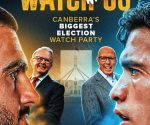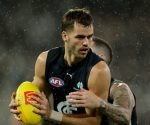They’re 6-1, but the Lions have a glaring weakness
Despite just one loss in their first seven matches of 2025, Brisbane’s reliance on its stellar midfield has the potential to derail its quest to go back-to-back.
The Lions have graduated to a spot where results are relatively inconsequential when analysing the group at this stage of the season.
This is a quality squad that should be targeting another flag. They’ve been a contender for a long time, they won the premiership last year, and they’ll do what they need to do in the home-and-away rounds.
The wins have kept coming this season, but the absence of the retired Joe Daniher has certainly hindered the smoothness of the playing group.
There’s an argument to be made that Brisbane has the best midfield in the league and any counter-argument would have to acknowledge that it’s in the top three, and it’s definitely the most prolific clearance group.
Dual Brownlow Medallist Lachie Neale leads the charge, Josh Dunkley has been a picture of consistency since joining the club, Hugh McCluggage has probably been their best player this season, and Will Ashcroft is already an above average player in the league and will lead this group within 12 months.
Add the rotational stoppage pieces like Cam Rayner, Zac Bailey and Levi Ashcroft, with an occasional sprinkling of Jarrod Berry inverting his positioning and lining an opponent up, and it’s easy to see how the quality of this extended group is almost too intoxicating to not fully rely upon.
Such an approach, though, has always been unsustainable, if the attacking isn’t able to provide consistent output, or if the defence is left too exposed at times.
Offensively, it’s not as if the Lions aren’t scoring – they’ve got the equal-fifth most points in the league after seven rounds.
Eric Hipwood has 16 goals in seven games to his name; he isn’t a dominating key forward that takes big contested marks, which is completely fine. He’s a hit-up, lower to the ground sort of tall that’s always suited to being the second or third target – now, though, he’s the number one banana with Daniher out of the picture.
Young Logan Morris has certainly exceeded all expectations immediately = he’s the second key guy. He’s stronger than Hipwood, but very undersized. He too ends up being more of a leading forward.
At the moment, the third tall is Sam Day, although he’s just floating around to be a moments sort of a player. All three are low-possession footballers who prefer to be closer to goal and not push up higher.
It’s why the Lions love relying on their medium and small types, but even then, Zac Bailey averaging 3.5 shots on goal per game is functioning at an elite level that we’ve not seen sustainably from him yet.
Cal Ah Chee has been an awesome avenue to goals as well, but him and Rayner aren’t going to consistently tear games apart, and have 13 goals between them so far in 2025.
Last season, Brisbane was one of the very best teams in terms of winning one-on-one contests. That’s not exclusively a forward-line metric, but it accounts for a majority of the numbers.
The stats tell us that Brisbane won nearly 29 per cent of their one-on-ones in 2024, ranked third. This season, it’s below 19 per cent, ranked 17th.
Daniher accounted for over 18 per cent of Brisbane’s total offensive one-on-ones, winning 31.7 per cent of his. He was also involved in 25.7 per cent of the Lions’ total scores.
Morris has taken over as the player participating in the most offensive one-on-ones at the Lions at a higher rate than even Daniher had, but has won seven per cent. Hipwood has participated in the second-most, and his winning percentage is at 10.
In terms of score involvements, it’s natural for midfielders to be ranked highly, but the numbers for McCluggage and Will Ashcroft have risen significantly and the forwards are not represented extremely well.
In fact, no other team currently in the top eight is as reliant on score involvements through its midfield, while also not winning one-on-ones in attack. Gold Coast’s midfielders dominate their score involvements, for example, but then they have a forward line that thrives on winning contests and hitting the scoreboard. Not quite the same.
It’s why we’re seeing Brisbane’s midfielders hold onto the ball a little longer: there’s no obvious contested mark relief player on offer.
As a consequence, they’re making a little less ground per disposal than previous seasons, which is relatively significant given the control in possession and high marking game they like to play.
Generally, Brisbane’s focus defensively is to limit how many clearances the opposition gets and then really try and play a half-court press when they’ve got control in the forward half. They haven’t been a high-pressure team, although their tackling inside 50 has generally been pretty good.
They limit transition through structure. They don’t force an obscene number of cheap turnovers, but they love to force a long kick down the line to Harris Andrews, Jack Payne or Ryan Lester to either kill a contest or take an intercept mark. That was the plan to win a flag.
Last year it was Cameron, Rayner, Hipwood and Kai Lohmann averaging around a tackle inside 50 a game, with Dunkley slightly ahead. A healthy reliance on the forward group, which allowed the midfielders to add to that pressure by positioning themselves around the arc and edge of the centre square.
In 2025, the forward 50 tackling is up. The players putting up good numbers are McCluggage (1.7 per game), Dunkley (1.3), Bailey (1.3), Cameron (1.2), Hipwood (1), Neale (1) and Will Ashcroft (1).
Again, that’s the entire main midfield group working hard to lock the ball in offensively, instead of playing higher up the ground.
How does that affect the team defensively? The raw numbers have only experienced a slight drop-off, but the league is defending the Lions’ transition a lot better as a whole.
Brisbane have gone from being top four in terms of how inefficient the opposition has been heading inside 50, to now being around league average.
Where the opposition was once facing the midfield group if they escaped the forwards, ultimately hitting a brick wall in transition, they’ve now got more space once they get out of their defensive 50.
Opposition teams want Brisbane defending fewer one-on-ones, mainly because the Lions are going to win at a higher rate, but also transition quickly.
The Lions are defending three fewer one-on-one contested contests and conceding two more marks on the lead per game. Harris Andrews’ intercept numbers have decreased as the opposition tries to hit leading targets, instead of giving him the opportunity to sweep up.
Without Brandon Starcevich available, it’s clear that defending at ground-level too is an issue. Medium-sized forwards are performing extremely well every week, and how they defend Ben Long, the most in-form mid-sized forward in the game, will be a major test.
At the most basic level, the Lions are conceding 83.3 points per game through their opening seven contests. In 2024, it was down at 76.
This midfield group is playing well and it’s deep, with plenty of rotational pieces able to have impact from stoppages around the ground. The fact they win at more footy at stoppages than anyone allows Brisbane to generally win field position, which can only be a positive.
But it’s the manner in which the Lions are approaching games, and indeed winning them, that is fraught with danger and it feels extremely high risk.
All it takes is the midfield to have an off day, a la the Collingwood game a fortnight ago, for everything to fall apart, which is perhaps the biggest issue.
This industrious and talented group is being relied upon to be top tier in the middle and to be leading pressure players offensively, while also hitting the scoreboard.

Jarrod Berry. (Photo by Russell Freeman/AFL Photos via Getty Images)
They also need to work hard running defensively to offer protection at ground-level defensively, so the intercept defenders can float around, knowing that the numbers have folded back to fill holes.
Truthfully, this version of Brisbane right now is reminiscent of Port Adelaide under Ken Hinkley previously. They always won a lot of games, they’ll tear apart teams that don’t compare in quality, but the sole reliance on the midfield takes its toll.
The Power’s win-loss record in home-and-away games in the past half-decade has been great. Never, have they been a flag threat.
This is the challenge that the Lions must overcome to defend their crown in 2025.
They’re certainly a contender, but having watched their games, it feels as though they’re at the end of the second or leading the third tier of teams challenging for the flag.
A complete team drop-off isn’t possible with the quality that Fagan has at his disposal, but it’s the coach’s prerogative to pre-emptively identify and ease the entire burden on this midfield group while the team is going well, rather than wait until it’s too late and face the ignominy of an early September exit.










